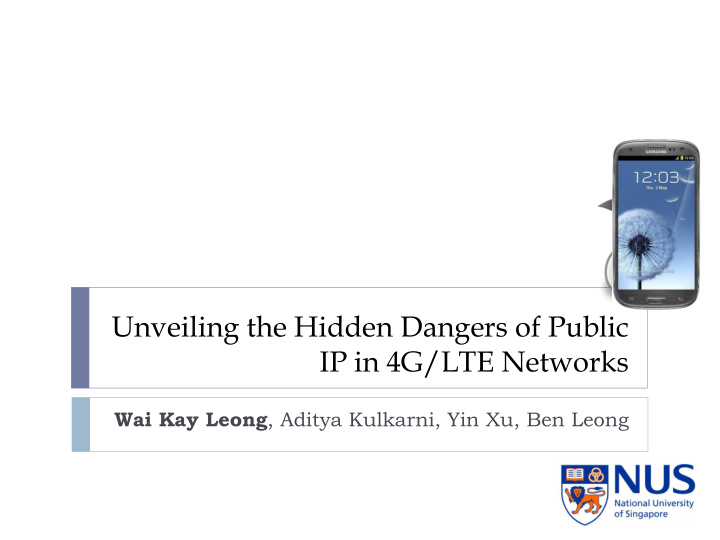



Unveiling the Hidden Dangers of Public IP in 4G/LTE Networks Wai Kay Leong , Aditya Kulkarni, Yin Xu, Ben Leong
Mobile Internet is Hot ot 2
Public IP – What’s the deal? Subscribers want Public IP 3
M2M M2M – Machine to Machine Delivery Vans Security Cameras Sensor Nodes Traffic Control 4
Our Local Situation Public IP by default † ISP A ISP B Change APN Change APN ISP C Free Public IP for LTE networks † Does not work for certain devices 5
The Dangers of Public IP Susceptible to simple IP attacks 1. DoS Flooding 2. Quota Drain 3. Battery Drain 10. 42. 0. 1 No r out e NAT Private IP Public IP t o hos t Attacker 10. 42. 0. 1 215. 12. 5. 1 6
Attack 1: DoS Flooding Overwhelm the link/resources Conventionally Higher bandwidth (30 Mb/s) Requires more data Malicious Packets Malicious Packets Normal traffic 7
Buffer Sizing Matters ISP Buffer ISP A 2,000 pkts ISP B 600 pkts ISP C 800 ms Xu et al. PAM 2014 ISP C uses AQM Low traffic is sufficient to DoS Drop packets older than 800 ms Sized in packets 1,500- byte packet ≡ 1 -byte packet 8
Experiment Set-up Send rate (Mb/s) Packet Size (bytes) UDP DoS Measure TCP throughput (kb/s) 9
Results 10
ISP C – AQM No packet drops Long UDP processing time Delays TCP SYN/ACK 11
Attack 2: Quota Drain Data cost $$$ Limited free quota. Billed for dropped packets (Peng et al.) 1. Billed for unwanted packets 2. Gateway Node-B 12
High Speed LTE 13
Time to Drain Quota 20 1 MB every 15 min over 1 month 14
Attack 3: Battery Drain Network communication consumes power LTE protocol states Incoming RRC CONNECTED data Active RRC IDLE Low power Long Short Timeout DRX DRX High power 15
Power Monitor Different ISPs Different patterns Same device Packet size does not matter More details in the paper 16
Battery Consumption 24 times faster drain 17
Defense Against Attacks Avoid Public IP Use Network Address Translation (NAT) NAT traversal can be slow not 100% successful requires NAT servers Firewalls? 18
Firewall on device Harm is already done ISP Subscriber Attacker 19
Firewall on ISP Hard to differentiate legitimate traffic Complex firewall hard to deploy ISP Subscriber Legitimate User Attacker 20
Proxy + Firewall ISP firewall allows solicited access Proxy Server Attacker can spoof as proxy ISP Subscriber IP: y.y.y.y Allows y.y.y.y IP: x.x.x.x src: y.y.y.y Attacker 21
Double IP address Give proxy a secret IP address Proxy Server IP: z.z.z.z ISP Subscriber IP: y.y.y.y Allows z.z.z.z IP: x.x.x.x src: y.y.y.y Attacker 22
In Summary Firewall prevents unsolicited access Proxy Server Secret IP prevents spoofing IP: z.z.z.z Proxy Firewall filters legitimate users ISP Subscriber IP: y.y.y.y Allows z.z.z.z Legitimate IP: x.x.x.x User src: y.y.y.y Attacker 23
Conclusion Public IP: Desirable, but Dangerous Best to avoid public IP Sometimes enabled by default! Attacks are Simple Requires little resources Can be hard to detect/differentiate Proxy Solution How effective or reliable? 24
Moving Forward… Mobile networks will be faster More users Personal Commercial Security is a concern P2P or M2M 25
Thank You Questions and Comments
Recommend
More recommend